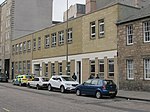King Khalid Building

The King Khalid Building is an event space in the Southside, Edinburgh, Scotland, owned and operated by the Royal College of Surgeons of Edinburgh. The building was constructed Roxburgh Free Church in 1847 and converted to its current use in 1982. The building's first occupants, Roxburgh Free Church, began as a Relief congregation in 1803, subsequently joining the Church of Scotland in 1833 then the Free Church at the Disruption of 1843. The congregation united with McCrie Free in 1886. Between 1888 and 1965, the buildings were occupied by St Michael's Episcopal Church. After a period of dereliction, the buildings were converted for use as a lecture theatre. In recognition of a major donation from King Khalid of Saudi Arabia, the building was given the full name: King Khalid bin Abdul Aziz of Saudi Arabia Symposium Hall. It also operates as a Fringe venue under the name Symposium Hall. The building was designed in the Gothic style by Thomas Hamilton and opened in 1847. It was altered by John Kinross ahead of its reopening as an Episcopal Church in 1888. In 1982, James Parr & Partners created the a two-storey interior with a lecture theatre above and smaller rooms below. A further renovation in 2005 increased the seating capacity.
Excerpt from the Wikipedia article King Khalid Building (License: CC BY-SA 3.0, Authors, Images).King Khalid Building
Richmond Place, City of Edinburgh Southside
Geographical coordinates (GPS) Address External links Nearby Places Show on map
Geographical coordinates (GPS)
| Latitude | Longitude |
|---|---|
| N 55.946719444444 ° | E -3.1838 ° |
Address
Symposium Hall
Richmond Place
EH8 9SS City of Edinburgh, Southside
Scotland, United Kingdom
Open on Google Maps









